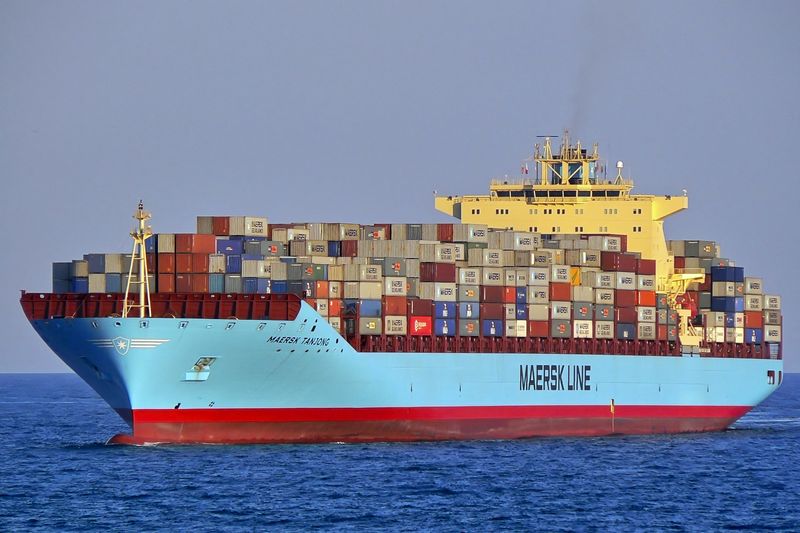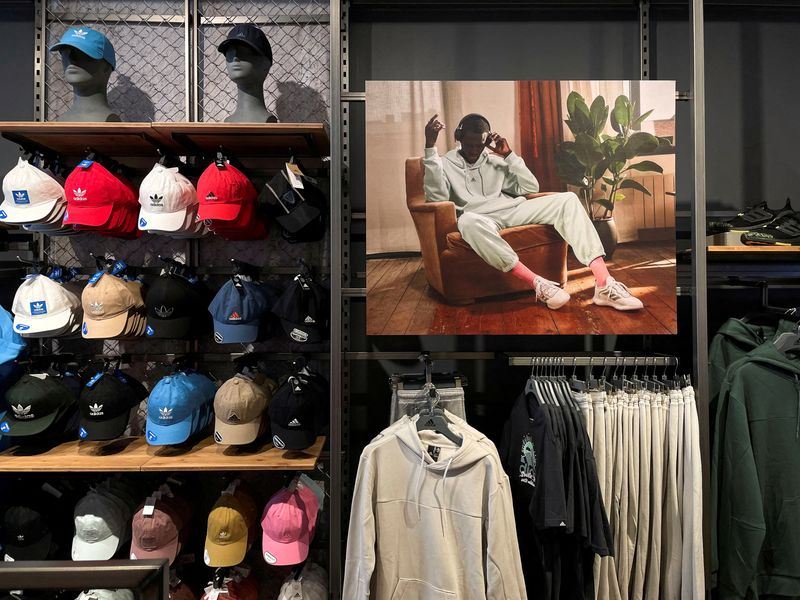By Richa Naidu
LONDON (Reuters) - When the Maersk Tanjong set sail from Thailand on Dec. 2, headed towards the Suez Canal to reach the U.S. East Coast, it was carrying cargo for retailers and clothing brands including Walmart (NYSE:WMT), H&M (ST:HMb), Adidas (OTC:ADDYY) and ASOS (LON:ASOS), import and shipping data shows.
On Dec. 17, it turned south to circumnavigate Africa's Cape of Good Hope, after Maersk paused sending vessels to the Suez through the Red Sea, where Houthi attacks on shipping have triggered delays, costs and uncertainty across global consumer and retail markets.
The diversion added thousands of miles and five days to the Tanjong's trip to Norfolk, Virginia. The loop around Africa adds around $1 million in extra fuel for to a trip to northern Europe, according to LSEG data.
Cargo ranging from raw prawns to high-end sneakers and plastic tubes was aboard Tanjong and three other diverted container vessels. Reuters was able to establish the containers' contents by cross-referencing U.S. import data provided by S&P Global Market Intelligence's Panjiva with a list of rerouted ships provided by tracking platform ShipsGo.
The reporting provides a glimpse of the sheer range of products carried in some of the hundreds of thousands of containers on more than 500 ships caught up in a crisis that shows little sign of abating.
Iranian-backed Houthi militants, who control much of Yemen, have launched wave after wave of exploding drones and missiles at Western commercial vessels in the Red Sea since Nov. 19, in what they say is a protest against Israel's military operations in Gaza.
The attacks follow a series of blows to the idea of seamless global trade, including rising protectionism, the COVID pandemic and climate-driven drought affecting the Panama Canal. The latest disruption could accelerate a shift towards shorter supply chains, often called "nearshoring," five executives and industry consultants told Reuters.
Responding to the prospect of a months-long crisis, some companies are already combining air, rail and sea shipping, ordering goods earlier and using factories closer to home, the five sources said.
Two shipping experts said such changes could have a long-term knock-on effect on how willing companies are to rely on the 154-year-old Suez Canal, which suffered a total blockage in 2021 that Maersk estimated cost $9 billion a day in lost trade.
Walmart, the world's biggest retailer, which had products including clothes on the Tanjong, told Reuters it was adjusting its supply chain "to help manage the recent shifts in shipping routes" and was focused on "maintaining inventory availability." It declined to provide details of the adjustments.
Even before the Houthi attacks, online fashion retailer ASOS had over the past year been sourcing more products from Britain and Morocco to cut transport times, the company said in response to questions about the impact of the delays. It said the hundreds of ASOS items coming from Asia on the Tanjong were unlikely to have included the most urgent 'trend' items.
Extended lead times could be factored into ASOS' purchasing decisions in the longer term, should the attacks persist, the company said.
As of Jan. 17, Maersk and other shipping lines had diverted at least 523 container ships from the Red Sea, ShipsGo data shows, while LSEG data shows a nearly 60% drop in container traffic in the waterway. Delays extend to more seven weeks in some cases.
The fast-moving and low-margin apparel industry is particularly exposed to the Red Sea delays because spring collections need to be in warehouses this time of year, and summer garments should follow shortly.
Peter Sand, chief analyst at air and ocean freight rate benchmarking platform Xeneta, said apparel companies were increasingly moving time sensitive cargos like the spring fashion collection by air instead of ocean shipping to final destinations in response to the crisis.
In response to questions about the Tanjong and other ships, Maersk said it was "in close dialogue with its customers regarding the situation in the Red Sea."
Swedish fast-fashion retailer H&M, which shipped garments on the Tanjong, said it still didn't foresee any "significant disruptions" in its supply chain but was "following the situation closely." It has previously said it was increasing the role of nearshoring "to be closer to the customer." Adidas declined to comment.
50-DAY-DELAY
Docking in Norfolk, Virginia on Jan. 19, the five-day delay to the Tanjong was relatively short. Some container ships, including Maersk's Londrina and San Clemente, started their voyages in November and are now not due to dock at their final destinations until mid-February, after delays of more than 50 days, ShipsGo data shows.
"Losses for retail will vary by sector," said Chris Rogers (NYSE:ROG), who manages the Supply Chain Research team within S&P Global. He flagged spoilage of food as an issue, as well as seasonal products.
Lars Jensen, CEO of shipping industry consultancy Vespucci Maritime said Valentines Day shipments that arrive after Feb. 14 would render "some merchandise next to worthless."
Jeans-maker Levi Strauss (NYSE:LEVI) said last week in a conference call that its operations, commercial and financial teams are "working around the clock," and that it is seeing a 10 to 14 day increase in transit times. The company has rerouted some products to go through the U.S. West Coast into the East Coast.
"If the current crisis continues through the second half of the year, there is some risk to (costs)," Levi's CFO Harmit Singh said, although he added that roughly 70% of Levi's ocean freight was under three-year contracts, with the rest under one-year contracts that shielded it from price hikes.
Container rates for key global trade routes soared in January, shipping industry officials and data firms say. Ocean freight rates are set to increase further in early February, according to data released last week by rate benchmarking platform Xeneta.
The biggest increase in average short-term rates is from the Far East into U.S. East Coast, which by Feb. 2 will cost up to $6,119 per 40-foot equivalent unit (FEU), a measure for shipping containers, the Xeneta data showed. This is an increase of 146% since mid December.
An industry source who declined to be named due to the sensitivity of the issue said it would take months to clean up after the Red Sea crisis is over, and predicted ripple effects including rising prices for air freight and rail.
The source said smaller retail and consumer goods companies were underestimating the impact of the Red Sea attacks, operating with a "wait-and-see" attitude, while only bigger companies coming up with contingency plans.
"Retailers will have to deploy tactical changes – such as earlier shipping or use of alternative routes like rail or trucking – if the disruptions continue until the middle of the year," said S&P Global's Rogers. "This is very much a matter of time."
A source at a company that imports ingredients and raw materials said "a multitude" of products had been affected but that overall disruptions to the company had so far been limited.
ARRAY OF GOODS
As well as sportswear and clothes, the Tanjong carried tools for Black & Decker along with baby bottles and Egyptian cotton sheets. Cargo on the three other ships, the Basle Express, the APL Le Havre and the MOL Courage, which all faced delays of just under a week, included LG fridges, Givaudan fragrances, Estee Lauder (NYSE:EL) cosmetics.
Estee Lauder, LG and Black & Decker did not respond to requests for comment.
Estee Lauder was shipping cosmetics, components, packaging and bottles according to the data, while Korean manufacturer Hyundai (OTC:HYMTF) Electric was importing transformers, and Samsung (KS:005930) was moving fridge parts. Hyundai Electric and Samsung did not respond to requests for comment.
Procter & Gamble (NYSE:PG) had cargo on the ships included the raw material sodium polyacrylate, plastic tubes - and Braun shaving products. P&G declined to comment.

Givaudan, the world's biggest fragrances and flavours company that sells raw materials to every large food and consumer goods maker in the world, loaded nearly 28,000 kilos of product onto the APL Le Havre. The ship docked on the U.S. East Coast on Dec. 15 after its own delayed journey around Africa, according to data from ShipsGo and ImportYeti.
Givaudan said potential supply chain disruptions were "a concern," but that it had business continuity plans for its global operations. It did not directly address the impact of the Red Sea attacks on its business.
